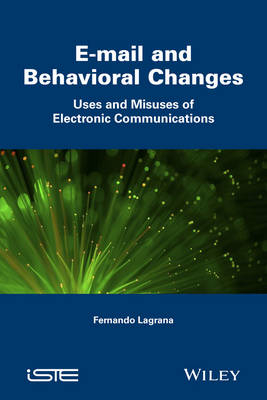
E-mail and Behavioral Changes
ISTE Ltd and John Wiley & Sons Inc (Verlag)
978-1-84821-850-5 (ISBN)
Have you ever felt overwhelmed by the number of e-mail and textual messages in your inbox, be it on your laptop, your Smartphone or your PC? This book should help you in finding a wealth of answers, tools and tactics to better surf the ICT wave in the professional environment, and develop proper protection strategies to mitigate your exposure to spam in any form.
Dr. Fernando A. Lagraña, Grenoble Ecole de Management/Webster University, Geneva.
Acknowledgements ix
Preface xi
Introduction xv
Chapter 1. Electronic Mail 1
1.1. Electronic mail, what is it exactly? 1
1.2. The most used communication tool in the professional world 2
1.2.1. E-mail or telephone? 2
1.2.2. A growth that is not slowing down 3
1.2.3. A perfectly adapted tool for a business in touch 4
1.3. Characteristics and beginning of misuse 4
1.3.1. A remote and asynchronous means of communication 5
1.3.2. Almost instantaneous and interactive 6
1.3.3. Textual 7
1.3.4. Ubiquitous and mobile 8
1.3.5. Which allows numerous messages to be sent 8
1.3.6. On to the storing and archiving of messages 9
1.4. E-mail versus other communication tools 10
1.5. The structure of e-mail and its susceptibility to misuse 12
1.5.1. Structure 12
1.5.2. Envelope and body of the message: two possible targets 14
1.6. Other forms of electronic communication, other flaws 15
1.6.1. Instant messaging 15
1.6.2. Micro-blogging 16
1.6.3. Social networks 17
1.7. Conclusion 17
Chapter 2. From Role to Identity 19
2.1. Roles, boundaries and transitions 19
2.1.1. Spatial and temporal boundaries 20
2.2. Roles 21
2.2.1. Definition 21
2.2.2. Role boundaries 23
2.2.3. Transitions between roles 26
2.3. Identities 28
2.4. Conclusion 30
Chapter 3. Roles and the Digital World 33
3.1. When electronic communications disrupt space-time 33
3.1.1. The transformation of space 34
3.1.2. The transformation of time 34
3.1.3. The transformation of distance 35
3.1.4. Mobility and ubiquity 37
3.2. Role transformation 38
3.2.1. Role boundaries 38
3.2.2. Flexibility 38
3.2.3. Permeability 41
3.2.4. Role separation 41
3.2.5. Transitions between roles 42
3.3. Conclusion 43
Chapter 4. Challenges in Communication 45
4.1. Interpersonal communication: a subtle tool 45
4.2. Misunderstanding in communication 46
4.2.1. Sources of misunderstanding 47
4.2.2. The absence of an operating communication channel 47
4.2.3. The absence of a common vocabulary 48
4.2.4. Exclusive information context 48
4.2.5. Situations involving incomprehension 49
4.2.6. Distance communication 49
4.2.7. Asynchronous communication 50
4.2.8. Heterogeneous competence domains or levels 50
4.2.9. Man–machine communication 50
4.2.10. E-mail: the accumulation of obstacles to comprehension 50
4.3. From misunderstanding to a lack of respect 51
4.4. A challenge for digital managers: communicating with the absent other 53
4.4.1. A lower volume of communication 53
4.4.2. A drop in communication quality 54
4.5. Conclusion 55
Chapter 5. Defining Spam 57
5.1. What is spam? 57
5.2. Preface: the influence of role on users’ perceptions of messages 57
5.3. Classifying e-mails according to role management theory 61
5.3.1. Roles and direct and indirect idiosyncratic connections 61
5.3.2. Roles played, transitions and perception of e-mail 65
5.4. Message classification model 68
5.4.1. E-mails received from unknown sources 68
5.4.2. Commercial spam 69
5.4.3. Fraudulent spam 70
5.4.4. E-mail received from known (trusted) sources 70
5.5. Conclusion 73
Chapter 6. A Lack of Ethics that Disrupts E-mail Communication 75
6.1. There is a new behavior behind every technical asset 75
6.2. Ethics and Information and Communication Technologies 76
6.3. Glossary of misuses and some of their consequences 79
6.4. Conclusion 104
Chapter 7. The Deadly Sins of Electronic Mail 105
7.1. Carefree exuberance 105
7.2. Confused identity 107
7.3. Cold indifference 108
7.4. Impassioned anger 109
7.5. Lost truth 111
7.6. The door of secrets 112
7.6.1. The ethical approach 112
7.6.2. The managerial approach 113
7.7. Fraudulent temptation 114
7.8. What answers should be given to these questions? 115
Chapter 8. The Venial Sins of Electronic Mail 117
8.1. Information overload 117
8.2. Anonymous disrespect 118
8.3. Communication poverty 118
8.4. Misunderstanding 119
8.4.1. Poorly written messages 119
8.4.2. Misread messages 119
8.4.3. When faced with misunderstanding, is empathy a solution? 120
8.5. Culpable ambiguity 120
8.6. Humor, love, rumors, and all the rest 120
Chapter 9. Exposure to Spam and Protection Strategies 123
9.1. Risk behaviors 123
9.1.1. Dynamic factors of spam exposure 124
9.1.2. Static factors of spam exposure 131
9.1.3. Other risks of spam exposure 133
9.2. Protection strategies 134
9.2.1. Keeping separate e-mail accounts 134
9.2.2. Using complex addresses 136
9.2.3. Treating received spam appropriately 136
9.2.4. Checking our e-proximity and network 138
9.2.5. Filters 139
9.2.6. Modify our sensitivity to spam 142
9.3. Conclusion 142
Concluding Recommendations 145
Bibliography 151
Index 157
| Verlagsort | London |
|---|---|
| Sprache | englisch |
| Maße | 165 x 241 mm |
| Gewicht | 431 g |
| Themenwelt | Informatik ► Netzwerke ► Mail Server |
| Informatik ► Software Entwicklung ► User Interfaces (HCI) | |
| Mathematik / Informatik ► Informatik ► Theorie / Studium | |
| ISBN-10 | 1-84821-850-8 / 1848218508 |
| ISBN-13 | 978-1-84821-850-5 / 9781848218505 |
| Zustand | Neuware |
| Haben Sie eine Frage zum Produkt? |
aus dem Bereich

